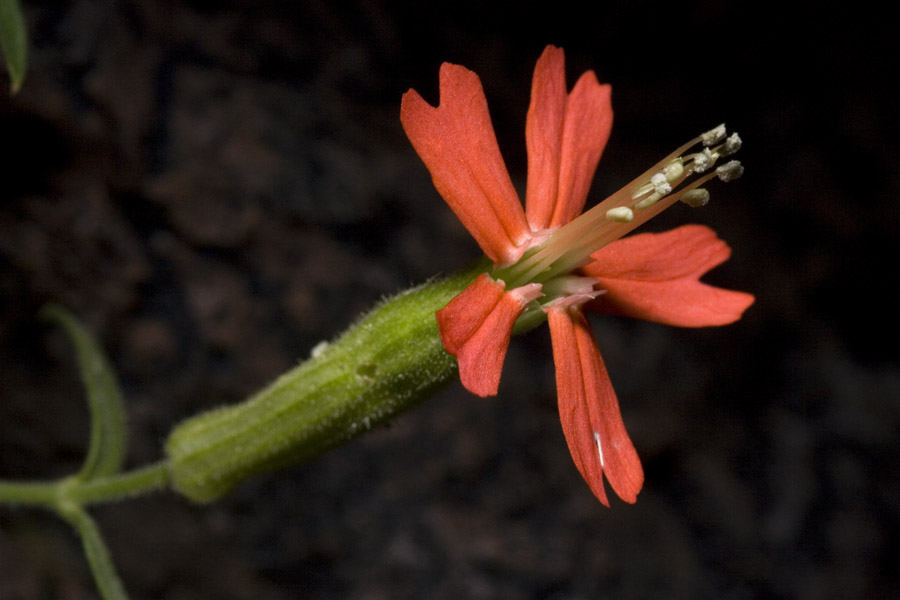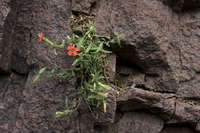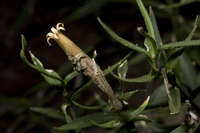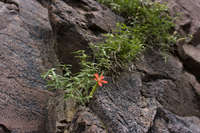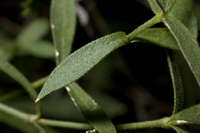
|
|
|
|
Family: Caryophyllaceae
Plank's Catchfly
|
Plants perennial, cespitose; tap-root stout; caudex with many often subterranean branches, woody. Stems ascending, branch-ed, wiry, leafy, slender, 10-20 cm, finely retrorse gray-puberulent. Leaves largest in mid-stem region; blade linear to narrowly lance-olate or oblance-olate, 1-4 cm × 1-5 mm, apex sharply acuminate, glandular-puberulent. Inflorescences with flowers usually solitary, terminal on branches. Pedicels shorter than calyx, glandular-puberulent. Flowers: calyx 10-veined, tubular, con-stricted around carpophore, umbilicate, 20-30 × 3-6 mm, papery, green, glandular-puberulent, lobes lanceolate, 2-4 mm, margins membranous, apex acute; corolla scarlet, clawed, claw equaling calyx, limb obconic, 2-lobed, 7-10 mm, margins entire or crenate, appendages ± lacerate, 1-1.5 mm; stamens exserted, ± equaling corolla lobes; styles 3, exserted, ± equaling corolla lobes. Capsules narrowly ellipsoid, equaling calyx, opening by 6 recurved, brittle teeth; carpophore ca. 5 mm. Seeds brown, reniform, 1.5 mm, rugose in concentric rings on sides, margins papillate. 2n = 48. Flowering summer-early autumn. Crevices in granite and quartzite cliffs; of conservation concern; 1300-2600 m; N.Mex., Tex.; Mexico. Silene plankii is a close relative of S. laciniata, differing in its compact tufted growth, small and narrow leaves, and shallowly two-lobed petals. It is endemic to the Del Carmen Mountains on either side of the Rio Grande valley. Plants of S. laciniata with a habit and leaves similar to S. plankii but the deeply laciniate petals of S. laciniata occur on the cliffs of Santa Cruz Island off the coast of California.
FNA 2005, NM Rare Plant Technical Council abstract (Bleakly 1999), Allred and Ivey 2012 Duration: Perennial Nativity: Native Lifeform: Forb/Herb General: Perennial herbs, 10-20 cm tall, from a stout taproot and branching woody caudex; stems wiry and slender, ascending and branching, finely puberulent with gray retrorse (downward-curving) hairs. Leaves: Opposite and sessile along the stem, with the largest leaves in the mid-stem region; blades linear to narrowly lanceolate or oblanceolate, 1-3 cm long and 1-5 mm wide, with a sharply long-pointed (acuminate) tip; surfaces covered with gland-tipped hairs. Flowers: Red and showy, solitary at branch tips, on glandular-puberulent pedicels; sepals 5, fused into a tube 2-3 cm long and 3-6 mm diameter, covered in gland-tipped hairs and prominently 10-veined; petals 5, scarlet, the limb (part of the petal that emerges from the calyx) obconic, 7-10 mm long, divided into 2 lobes near the tip, the edges entire or with rounded teeth. Fruits: Capsules narrowly ellipsoid, about the same length as the calyx, opening by 6 recurved, brittle teeth; containing many tiny brown, kidney-shaped seeds. Ecology: Found on igneous cliffs and rocky ledges and crevices, from 4,200-8,500 ft (1280-2591 m); flowers July-September. Distribution: Endemic to the mountains immediately adjacent to the Rio Grande Valley in New Mexico, west Texas, and the northern border of Mexico. Notes: This striking cliff-dwelling perennial herb is only found in the central mountain chain running parallel to the Rio Grande River. Recognize it from its showy 5-petaled red flowers, with each petal split into 2 lobes near the tip; long narrow opposite leaves; and herbage covered with gland-tipped hairs (use your hand lens). Silene plankii is most closely related to the common and widespread S. laciniata. S. plankii is smaller (usually 10-15 cm tall vs. S. laciniata at 20-60 cm tall); has smaller leaves (1-3 cm long and 1-3 mm wide, compared to S. laciniata with leaves usually longer than 2.5 cm and wider than 3 mm); and has differently-shaped flower petals (each petal divided into 2 lobes in S. plankii, compared to petals that are multi-lobed or lacinate (irregularly lobed) in S. laciniata. This is a species of conservation concern, and is on the New Mexico Rare Plant List. Ethnobotany: Unknown Editor: AHazelton 2017 |
This project was made possible in part by the Institute of Museum and Library Services [MG-70-19-0057-19].
Powered by Symbiota

